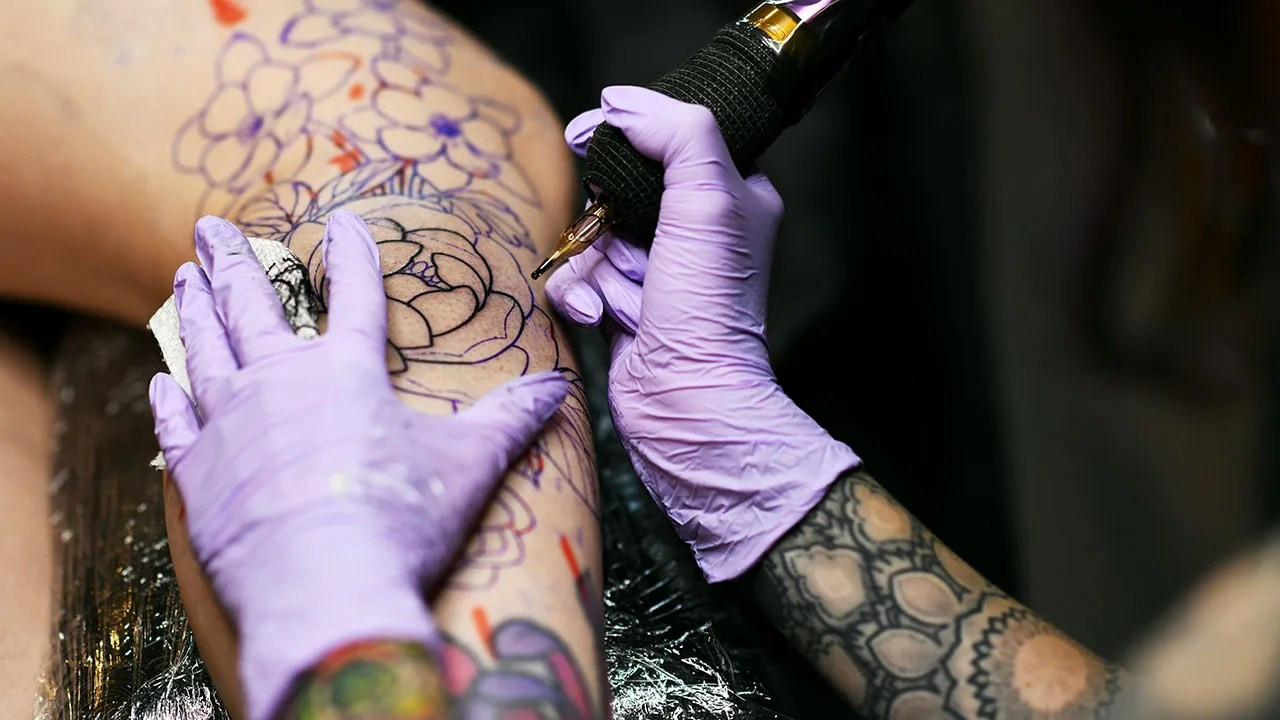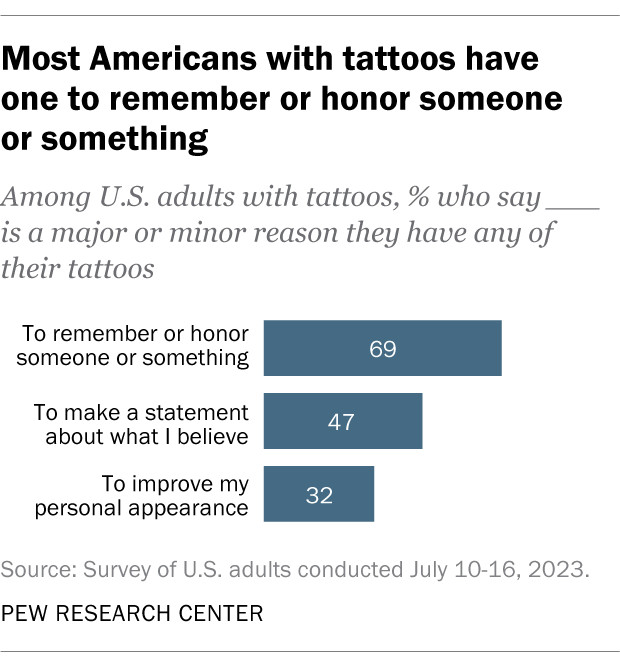Are you curious about how many people are embracing the art of tattooing? How Many People Get Tattoos is a fascinating question that unveils evolving societal views on body art and personal expression. At tattooat.com, we’re dedicated to exploring the world of ink, providing insights into tattoo prevalence, designs, and the cultural significance behind them, all while connecting you with the best artists and inspiration. Discover the popularity of tattoos, demographics, and explore tattoo culture today.
1. What Percentage of the US Population Has Tattoos?
Approximately 32% of adults in the United States have at least one tattoo. This figure highlights a significant shift in attitudes towards tattoos, making them a mainstream form of self-expression.
The increasing acceptance of tattoos reflects a broader cultural trend towards individuality and personal storytelling. According to a 2023 Pew Research Center survey, a large majority of U.S. adults agree that society has become more accepting of people with tattoos in recent decades. This growing acceptance is evident in various aspects of life, from workplaces to popular culture, indicating a profound change in societal norms. The data suggests that tattoos are becoming less stigmatized and more recognized as a form of art and personal expression.
2. What Demographic Groups Are Most Likely to Have Tattoos?
Several demographic factors influence the likelihood of having a tattoo, including gender, race, age, education, income, religion, and sexual orientation. Understanding these trends helps to paint a more complete picture of tattoo culture in America.
2.1. Gender
Women are more likely than men to have tattoos, with 38% of women having at least one tattoo compared to 27% of men. This trend is particularly pronounced among younger women, with 56% of women ages 18 to 29 and 53% of women ages 30 to 49 sporting tattoos.
2.2. Race and Ethnicity
There are notable differences in tattoo prevalence across racial and ethnic groups. Black Americans are the most likely to have tattoos, with 39% reporting at least one tattoo. Hispanic Americans follow closely at 35%, while 32% of White Americans and 14% of Asian Americans have tattoos.
2.3. Age
Younger adults are significantly more likely to have tattoos. Among adults under 30, 41% have at least one tattoo, while 46% of those ages 30 to 49 are tattooed. This contrasts sharply with older adults, with only 25% of those ages 50 to 64 and 13% of those 65 and older having tattoos.
2.4. Education
Education level appears to have an inverse relationship with tattoo prevalence. Adults with some college education or less are more likely to have tattoos, with 37% reporting at least one tattoo. In comparison, 24% of those with a bachelor’s degree and 21% of those with a postgraduate degree have tattoos.
2.5. Income
Similarly, income level is inversely related to tattoo prevalence. Lower-income adults are more likely to have tattoos, with 43% reporting at least one tattoo. This compares to 31% of middle-income adults and 21% of upper-income adults.
2.6. Religion
Religious affiliation also plays a role in tattoo prevalence. Adults who are religiously unaffiliated are more likely to have tattoos, with 41% reporting at least one tattoo. Among those affiliated with a religion, 29% have tattoos.
2.7. Sexual Orientation
Lesbian, gay, or bisexual Americans are significantly more likely to have tattoos. Approximately 51% of this group has at least one tattoo, with a particularly high rate among women (68%). Among straight Americans, 31% have tattoos.
 Close-up of a woman's arm with colorful tattoos
Close-up of a woman's arm with colorful tattoos
These demographic trends underscore the diverse nature of tattoo culture in the United States, showcasing how personal identity and cultural background intersect with the decision to get inked.
3. What Are the Most Common Motivations for Getting a Tattoo?
Why do people choose to get tattoos? Understanding the motivations behind getting inked provides insight into the personal and cultural significance of tattoos.
3.1. Honoring or Remembering Someone or Something
The most common reason for getting a tattoo is to honor or remember someone or something. According to the Pew Research Center survey, 69% of tattooed adults cite this as either a major or minor reason for getting a tattoo.
3.2. Making a Statement About Beliefs
Nearly half (47%) of tattooed adults say they got a tattoo to make a statement about what they believe. This motivation reflects the power of tattoos as a form of self-expression and a way to communicate personal values.
3.3. Improving Personal Appearance
About 32% of tattooed adults say they got at least one tattoo to improve their personal appearance. This motivation highlights the aesthetic appeal of tattoos and their role in enhancing one’s self-image.
3.4. Demographic Differences in Motivations
Motivations for getting tattoos can vary across demographic groups. For example, women are more likely than men to say that remembering or honoring someone is a reason for their tattoo (73% vs. 63%). Additionally, Black adults are more likely than Hispanic and White adults to say that making a statement about their beliefs is a reason for their tattoo (56% vs. 46% and 44%, respectively). Black adults are also more likely to say that improving their personal appearance is a reason for getting a tattoo (42% vs. approximately 30% of Hispanic and White adults).
These diverse motivations underscore the deeply personal and multifaceted nature of tattoos, highlighting their role as a means of remembrance, self-expression, and aesthetic enhancement.
4. Do People Regret Getting Tattoos?
While tattoos are often seen as permanent expressions of identity, some people do experience regret. Understanding the prevalence and reasons behind tattoo regret can provide valuable insights.
4.1. Prevalence of Tattoo Regret
The majority of tattooed Americans do not regret getting a tattoo. However, about a quarter (24%) say they ever regret getting one or more of their tattoos. This suggests that while tattoos are generally seen as positive choices, a significant minority experiences some level of regret.
4.2. Demographic Differences in Regret
Tattoo regret varies across demographic groups. Hispanic adults are more likely to report regretting any of their tattoos, with 30% expressing regret compared to 23% of White adults and 21% of Black adults. Additionally, adults with some college education or less are more likely to regret their tattoos, with 25% reporting regret compared to 19% of those with a bachelor’s degree or more.
Understanding these patterns of regret can help individuals make more informed decisions about getting tattoos, considering factors such as design choice, artist selection, and long-term personal values.
5. What Factors Influence the Likelihood of Getting a Tattoo in the Future?
For those who don’t currently have tattoos, what factors might influence their decision to get one in the future? Exploring these factors can provide insights into the potential growth of tattoo culture.
5.1. Future Tattoo Intentions
The vast majority (85%) of Americans who don’t have a tattoo say they are not too or not at all likely to get one in the future. However, 9% say they are somewhat likely to get one, while 6% say they are extremely or very likely to do so.
5.2. Age
Younger adults are more likely than older adults to say they are likely to get a tattoo in the future. Among untattooed Americans, 19% of those under 30 say they are extremely or very likely to get a tattoo, compared to 7% of those ages 30 to 49, 2% of those ages 50 to 64, and 1% of those 65 and older.
5.3. Race and Ethnicity
Hispanic adults are more likely than other racial and ethnic groups to express interest in getting a tattoo. Among untattooed Americans, 13% of Hispanic adults say they are extremely or very likely to get a tattoo, compared to 8% of Black adults, 5% of Asian adults, and 3% of White adults.
5.4. Income
Adults without tattoos in lower- and middle-income households are more likely than those in upper-income households to say they’re extremely or very likely to get one. About 8% of lower-income adults and 6% of middle-income adults say this, compared to 2% of upper-income adults.
These factors suggest that the future of tattoo culture may continue to be shaped by younger generations, diverse racial and ethnic groups, and individuals from lower- and middle-income backgrounds.
 A person's back with a large, intricate tattoo design
A person's back with a large, intricate tattoo design
6. How Do Untattooed Individuals Perceive People with Tattoos?
Perceptions of tattoos can vary among those who don’t have them. Understanding these perceptions can shed light on the social acceptance and cultural significance of tattoos.
6.1. General Impressions
Among Americans who don’t have tattoos themselves, about three-in-ten (29%) say that seeing a tattoo on someone gives them a more negative than positive impression of that person. Just 5% say tattoos leave a more positive than negative impression. However, the largest share of untattooed adults (66%) say seeing a tattoo on someone else leaves them with neither a positive nor negative impression of that person.
6.2. Gender Differences
Men without tattoos are slightly more likely than women without tattoos to have a more negative impression of someone with a tattoo (32% vs. 27%).
6.3. Age Differences
There are differences by age, too. Among Americans without tattoos, 40% of those ages 65 and older say seeing someone with a tattoo gives them a more negative than positive impression of that person. Younger adults are less likely to hold this view.
These perceptions highlight the ongoing evolution of attitudes towards tattoos, with older generations potentially holding more negative views compared to younger generations.
7. Has Society’s Acceptance of Tattoos Changed Over Time?
One of the most significant trends in tattoo culture is the increasing acceptance of tattoos in society. Understanding this shift can provide context for the growing popularity of tattoos.
7.1. Broad Societal Trends
Americans overall – including those with and without tattoos – believe society has become more accepting of people with tattoos over the past 20 years or so. Eight-in-ten U.S. adults say this, while far fewer (7%) say society has become less accepting of tattooed people. Another 12% say societal acceptance of people with tattoos has stayed about the same over the past two decades.
This broad consensus underscores the profound shift in attitudes towards tattoos, reflecting a greater appreciation for self-expression and individuality.
8. How Do Tattoos Impact Career Opportunities?
Tattoos have become more accepted in the workplace, but do they still impact career opportunities? Understanding the current landscape can help individuals make informed decisions about body art.
8.1. Workplace Acceptance
Tattoos are increasingly visible in workplaces across the United States, with many companies relaxing their policies on visible tattoos. This shift reflects the broader societal trend towards greater acceptance of tattoos.
8.2. Potential Limitations
Despite increasing acceptance, some industries and professions may still have reservations about visible tattoos. For example, customer-facing roles or more conservative industries may have stricter policies.
8.3. Making Informed Decisions
Individuals considering tattoos should be aware of their industry’s policies and potential perceptions. Choosing tattoo placements that can be easily covered may be a strategic approach for those concerned about career implications.
9. What Are Some Popular Tattoo Styles and Trends?
Exploring popular tattoo styles and trends can provide inspiration for those considering getting inked. Here are a few styles and trends:
9.1. Fine Line Tattoos
Fine line tattoos involve delicate, intricate designs created with thin needles. This style is known for its minimalist aesthetic and precise detail.
9.2. Watercolor Tattoos
Watercolor tattoos mimic the look of watercolor paintings, with soft, flowing colors and blurred edges. This style is often used to create vibrant and artistic designs.
9.3. Geometric Tattoos
Geometric tattoos feature precise shapes and patterns, often incorporating elements of symmetry and mathematical concepts. This style can range from simple designs to complex, visually striking compositions.
9.4. Blackwork Tattoos
Blackwork tattoos use solid black ink to create bold, graphic designs. This style is often used for tribal patterns, abstract shapes, and modern art-inspired pieces.
9.5. Neo-Traditional Tattoos
Neo-traditional tattoos blend elements of traditional tattooing with modern aesthetics. This style often features bold outlines, vibrant colors, and detailed imagery.
These styles represent just a few of the many diverse and evolving trends in tattoo culture, offering endless possibilities for personal expression and artistic creativity.
 A collage of different tattoo styles, including fine line, watercolor, and geometric
A collage of different tattoo styles, including fine line, watercolor, and geometric
10. What Are the Health and Safety Considerations When Getting a Tattoo?
Prioritizing health and safety is essential when getting a tattoo. Understanding the potential risks and precautions can help ensure a positive experience.
10.1. Choosing a Reputable Artist and Studio
Select a tattoo artist and studio with a strong reputation for cleanliness, hygiene, and professionalism. Check online reviews, ask for recommendations, and visit the studio to assess its safety standards.
10.2. Ensuring Proper Sterilization
Ensure that the tattoo artist uses sterile, single-use needles and equipment. The studio should follow strict sterilization protocols to prevent the transmission of infections.
10.3. Understanding Aftercare
Follow the tattoo artist’s aftercare instructions carefully to promote proper healing and prevent infections. This typically involves keeping the tattoo clean, moisturized, and protected from the sun.
10.4. Potential Risks
Be aware of the potential risks associated with tattoos, such as allergic reactions to ink, skin infections, and scarring. Consult a healthcare professional if you experience any adverse reactions.
Prioritizing these health and safety considerations can help ensure a safe and positive tattoo experience, allowing you to enjoy your body art with peace of mind.
At tattooat.com, we understand the importance of making informed decisions about tattoos. That’s why we provide comprehensive resources and information to help you navigate the world of ink with confidence.
Ready to explore the world of tattoos? Visit tattooat.com to discover a vast collection of tattoo designs, find talented artists, and learn everything you need to know about tattoo culture. Whether you’re seeking inspiration, guidance, or connections, tattooat.com is your ultimate destination for all things tattoo-related.
(Address: 1825 SW Broadway, Portland, OR 97201, United States. Phone: +1 (503) 725-3000. Website: tattooat.com.)
FAQ: Frequently Asked Questions About Tattoos
1. How permanent are tattoos?
Tattoos are considered permanent, but laser tattoo removal is an option if you regret your tattoo.
2. Do tattoos hurt?
Pain levels vary depending on the location of the tattoo and individual pain tolerance.
3. How much do tattoos cost?
Tattoo prices vary based on size, complexity, and the artist’s rates.
4. Can I be allergic to tattoo ink?
Yes, allergic reactions to tattoo ink are possible, but they are relatively rare.
5. How long does it take for a tattoo to heal?
Tattoos typically take 2-4 weeks to heal, but healing times can vary.
6. What should I do if my tattoo gets infected?
Consult a healthcare professional immediately if you suspect your tattoo is infected.
7. Can I donate blood after getting a tattoo?
You may need to wait a certain period before donating blood after getting a tattoo, depending on local regulations.
8. Will my tattoo fade over time?
Tattoos can fade over time due to sun exposure and natural aging, but proper aftercare can minimize fading.
9. Can I get a tattoo if I have sensitive skin?
People with sensitive skin can get tattoos, but it’s essential to choose a reputable artist and discuss any concerns beforehand.
10. Are there any cultural or religious restrictions on getting tattoos?
Some cultures and religions have restrictions or negative views on tattoos, so it’s essential to be aware of these considerations.
